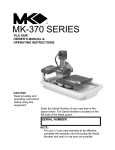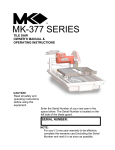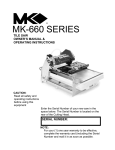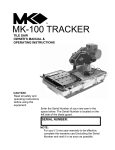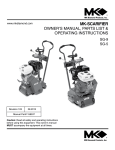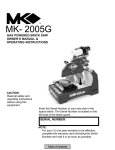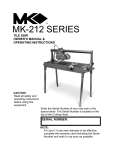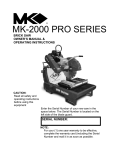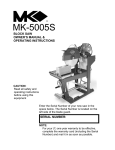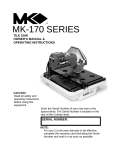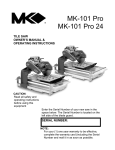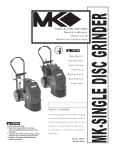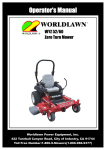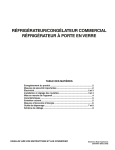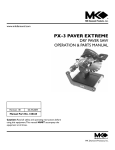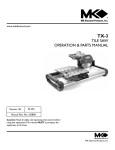Download MK Diamond Products MK CX-3 Owner`s manual
Transcript
MK CX-3 GAS POWERED CONCRETE SAW OWNER’S MANUAL & OPERATING INSTRUCTIONS CAUTION: Read all safety and operating instructions before using this equipment Enter the Serial Number of your new saw in the space below. The Serial Number is located on the Rear Crossbar SERIAL NUMBER: NOTE: For your (1) one year warranty to be effective complete the warranty card (including the Serial Number) and mail it in as soon as possible. INTRODUCTION and TABLE OF CONTENTS INTRODUCTION: We at MK Diamond want to congratulate you on selecting the MK CX-3 Concrete Saw. We are certain that you will be pleased with your purchase. MK Diamond takes pride in producing the finest products in the industry. Operated correctly, your MK CX-3 should provide you with years of quality service. In order to help you, we have included this manual. This owner’s manual contains information necessary to operate and maintain your MK CX-3 safely and correctly. Please take a few minutes to familiarize yourself with the MK CX-3 by reading and reviewing this manual. If you should have questions concerning your MK CX-3, please feel free to call our friendly customer service department at: 800 421-5830 TABLE OF CONTENTS Page SAFETY: Safety Messages Damage Prevention Message General Safety Precautions and Hazard Symbols California Proposition 65 Message Safety Label Locations Brick Saw Specific Warnings Product Specifications 3 3 3 5 6 7 7 UNPACKING AND ASSEMBLY Unpacking Contents Transport Assembly 8 8 9 10 SETUP, STARTUP, ADJUSTMENT AND OPERATION Setup Start Up Adjustment and Operation Cleanup 15 16 17 20 MAINTENANCE AND TROUBLESHOOTING Maintenance 21 EXPLODED VIEW AND PARTS LIST Exploded View Parts List 37 38 THEORY Theory of Diamond Blades 42 ACCESSORIES, ORDERING and RETURN INSTRUCTIONS Accessories Ordering Information Return Material Policy Packaging Instructions Authorized Service Centers 43 44 44 44 44 Manual Part No. 159348 MK CX-3 Revision 07/15 Revision 09/04, Effective Date September 17, 2004 Page 2 SAFETY Read and follow all safety, operating and maintenance instructions. Failure to read and follow these instructions could result in injury or death to you or others. Failure to read and follow these instructions could also result in damage and/or reduced equipment life. SAFETY MESSAGES: Safety messages inform the user about potential hazards that could lead to injury, death and/or equipment damage. Each safety message will be preceded by one of the following (3) three words that identify the severity of the message. Not following instructions WILL lead to DEATH or SERIOUS INJURY Not following instructions COULD lead to DEATH or SERIOUS INJURY Not following instructions CAN lead to injury DAMAGE PREVENTION AND INFORMATION MESSAGES: A Damage Prevention Message is to inform the user of important information and/or instructions that could lead to equipment or other property damage if not followed. Information messages convey information that pertains to the equipment being used. The word note, as in the example below will precede each message. NOTE: Equipment and/or property damage may result if these instructions are not followed. GENERAL SAFETY PRECAUTIONS AND HAZARD SYMBOLS: In order to prevent injury, the following safety precautions and symbols should be followed at all times! Safety Precautions: KEEP GUARDS IN PLACE. In order to prevent injury, keep guards in place and in working order at all times. EXPLOSIVE FUEL! Gasoline is extremely flammable, its vapors can explode if ignited; store only in approved containers, in well-ventilated, unoccupied buildings and away from sparks or flames. Do not fill the fuel tank while the engine is running or hot. Spilled fuel could ignite if it contacts hot parts or sparks from ignition. Do not start the engine near spilled fuel. Never use gasoline as a cleaning agent. LETHAL EXHAUST GASES! Engine exhaust gasses contain poisonous carbon monoxide, an odorless colorless gas that can cause death if inhaled. Avoid inhaling exhaust fumes, and never run the engine in a closed building or confined area. ELECTRICAL SHOCK! Never touch electrical wires or components while the motor is running. Exposed, frayed or worn electrical motor wiring can be sources of electrical shock that could cause severe injury or burns. (( ENGINE OVER-SPEED. )) Never tamper with the governor components or settings to increase the maximum speed of the machine. Severe personal injury and/or equipment damage could result if the equipment is operated speeds above design maximum. MK CX-3 Revision 09/04, Effective Date September 17, 2004 Page 3 SAFETY ACCIDENTAL STARTS! on Before starting the engine, be sure the ON/OFF switch is in the "OFF" position to prevent accidental starting. Place the ON/OFF switch in the OFF position before performing any service operation. ROTATING OR MOVING PARTS! Keep hands, feet, hair, and clothing away from all moving parts to prevent injury. Never operate a power tool with shrouds or guards removed. HOT PARTS! Engine components can become extremely hot from operation. To prevent severe burns, do not touch these areas while the engine is running, or immediately after it is turned off. Never operate the engine with heat shields removed. ALWAYS USE SAFETY GLASSES! Safety glasses should always be worn when working around power tools. Everyday eyeglasses only have impact resistant lenses and may not prevent eye injury; they are NOT safety glasses. ALWAYS USE RESPIRATORY PROTECTON! Exhaust gases may be harmful if inhaled. Do not operate gas-powered equipment in enclosed spaces. Respiratory protection should be worn when operating gas-powered equipment. ALWAYS USE HEARING PROTECTION! To reduce the possibility of hearing loss, always use hearing protection when operating equipment. REMOVE ADJUSTING KEYS AND WRENCHES. Form a habit of checking to see that keys and adjusting wrenches are removed from the power tool before it is turned on. KEEP WORK AREA CLEAN. Cluttered work areas and benches invite accidents. DO NOT USE IN DANGEROUS ENVIRONMENTS. Do not operate equipment in dangerous environments. Always keep the work area well lighted. KEEP CHILDREN AWAY. All visitors and children should be kept a safe distance from work area. MAKE WORKSHOP KID PROOF. Make the workshops kid proof by using padlocks, master switches or by removing starter keys. DO NOT FORCE THE TOOL. A power tool will do a job better and safer operating at the rate for which it was designed. USE THE RIGHT TOOL. Do not force a tool or an attachment, to do a job that it was not designed to do. WEAR PROPER APPAREL. Do not wear loose clothing, gloves, neckties, rings, bracelets, or other jewelry that may be caught in moving parts. Nonslip footwear is recommended. Wear protective hair covering to contain long hair. SECURE WORK. Clamps or a vise should be used to hold work whenever practical. Keeping your hands free to operate a power tool is safer. MK CX-3 Revision 09/04, Effective Date September 17, 2004 Page 4 SAFETY DO NOT OVERREACH. Keep proper footing and balance at all times by not overreaching. MAINTAIN TOOLS WITH CARE. Keep tools sharp and clean for the best and safest performance. Always follow maintenance instructions for lubricating and when changing accessories. SHUTDOWN TOOL. The saw should always be shutdown before servicing or when changing accessories such as blades, bits, cutters, and the like. USE RECOMMENDED ACCESSORIES. Consult the owner's manual for recommended accessories. Using improper accessories may increase the risk of personal or by-stander injury. NEVER STAND ON THE TOOL. Serious injury could occur if a power tool is tipped, or if a cutting tool is unintentionally contacted. NEVER LEAVE TOOL RUNNING UNATTENDED – TURN POWER OFF. Do not leave a tool until it comes to a complete stop. Always turn a power tool OFF when leaving the work area, or, when a cut is finished. CHECK FOR DAMAGED PARTS. Before using a power tool, check for damaged parts. A guard or any other part that is damaged should be carefully checked to determine it would operate properly and perform its intended function. Always check moving parts for proper alignment or binding. Check for broken parts, mountings and all other conditions that may affect the operation of the power tool. A guard or any damaged part should be properly repaired or replaced. DIRECTION OF FEED. Always feed work into a blade or cutter against the direction of rotation. A blade or cutter should always be installed such that rotation is in the direction of the arrow imprinted on the side of the blade or cutter. Sawing and drilling generates dust. Excessive airborne particles may cause irritation to eyes, skin and respiratory tract. To avoid breathing impairment, always employ dust controls and protection suitable to the material being sawed or drilled; See OSHA (29 CFR Part 1910.1200). Diamond Blades improperly used are dangerous. Comply with American National Standards Institute Safety Code, B7.1 and, Occupational Safety and Health Act covering Speed, Safety Guards, Flanges, Mounting Procedures, General Operating Rules, Handling, Storage and General Machine Conditions. CALIFORNIA PROPOSITION 65 MESSAGE: Some dust created by power sanding, sawing, grinding, drilling, and other construction activities contain chemicals known [to the State of California] to cause cancer, birth defects or other reproductive harm. Some examples of these chemicals are: • Lead, from lead-based paints • Crystalline silica, from bricks and cement and other masonry products • Arsenic and chromium, from chemically treated lumber Your risk from these exposures varies depending on how often you do this type of work. To reduce your exposure to these chemicals, work in a well-ventilated area, and work with approved safety equipment, such as those dust masks that are specially designed to filter out microscopic particles. For further information, consult the following sources: http://www.osha-slc.gov/sltc/silicarystalline/index.html http://www.oehha.org/prop65/out_of_date/6022kLstA.html MK CX-3 Revision 09/04, Effective Date September 17, 2004 Page 5 SAFETY SAFETY LABEL LOCATIONS: Safety labels are located according to Figures 1 to 7 below. The labels contain important safety information. Please read the information contained on each safety label. These labels are considered a permanent part of your saw. Please, contact MK Diamond or your dealer for a replacement, if a label comes off or becomes hard to read. Item 1 2 3 4A 4B 5 6A 6B 6C 6D 7A 7B 7C 7D Location Console Assembly Horizontal Frame Support Outer Blade Guard Inner Blade Guard Shaft Cover Fuel Tank – Right Side Fuel Tank – Top Fuel Tank – Top Fuel Tank – Top Fuel Tank – Front Belt Guard Belt Guard Belt Guard Belt Guard Description Operating and Safety Instructions Serial Tag Warning – Blade Failure Caution – Do Not Lift Blade Guard Caution – Do not Operate with Guards Removed Warning – When Refueling Stop Engine Danger – California Warning Warning – Engine Mfg. Label Caution – Hot Surface Danger – Lethal Exhaust Caution – Do Not Operate with Guards Removed Caution – Accidental Start Hazard Caution – Over tensioning Belt Hazard Caution – Keep Hands and Feet Clear 1 3 2 A B B C D A 5 4 B Part No. 159208 159251 155588 155586 155587 155580 155581 N/A 155578 155582 155587 155579 155583 155585 6 6 C A D 7 MK CX-3 Revision 09/04, Effective Date September 17, 2004 Page 6 SAFETY CX-3 SPECIFIC WARNINGS: Read Owners Manual Wear Protective Gear for – Lungs Ear Eye PRODUCT SPECIFICATIONS: The MK CX-3 is a versatile Concrete Saw. Operated and used according to this manual, the MK CX-3 will provide years of dependable service. General Description: The MK CX – 3 is engineered as a portable concrete saw powered by a 6 horsepower, Robin gas engine or a 6.5 horsepower Honda gas engine. The saw is capable of cutting up to five (5) inches in depth. Motor and Weight Specifications: Motor and Weight specifications for the MK CX-3 are listed in Table 2 below. Motor Type Max Power Output Max RPM Blade Speed Fuel Tank Capacity Engine Oil Capacity Weight 4-stroke, Overhead valve, single cylinder 6 / 6.5 Hp 3600 RPM 3400 to 3600 RPM (Depending on Blade Diameter) 2.7 Liters 0.6 Liters Approximately 185 lbs. Table 2 Blade: The MK CX-3 uses a 12 to 14 inch diameter diamond blade. Concrete Saw Usage: The MK CX-3 is designed to cut various grades of concrete surfaces. Features: • Conveniently placed engine controls for ease of usage • Height adjusting screw designed to accurately adjust the depth of the cut • Ergonomically designed handlebar to reduce operator fatigue • Poly micro V-belt to ensure maximum power transfer from the engine to the blade. MK CX-3 Revision 09/04, Effective Date September 17, 2004 Page 7 UNPACKING, TRANSPORT and ASSEMBLY UNPACKING: Your MK CX-3 has been shipped from the factory thoroughly inspected. Only minimal assembly is required. If not already done, remove the MK CX-3 from the pallet and place it on a flat surface (lift the Concrete Saw using the lifting points shown below. CONTENTS: In the containers, you will find one (1) MK CX-3, one (1) Diamond Blade, two (2) Blade Shaft Wrenches, one (1) Handlebar, two (2) Handlebar Tri-knobs, two (2) Tri-Knob Washers, one (1) Ball Knob, one (1) Shoulder Bolt, one (1) Pointer Arm, one (1) Pointer Wheel, one (1) Pointer, one (1) CX-3 Owners Manual, one (1) Robin’s or Honda’s Engine Owners Manual and one (1) warranty card. MK CX-3 Diamond Blade 2 Blade Shaft Wrench Handlebar Handlebar Tri-Knob Tri-Knob Washer Ball Knob & Shoulder Bolt Pointer Arm Pointer Wheel Pointer CX-3 Owners Manual Robin or Honda Owner’s Manual Warranty Card MK CX-3 Revision 09/04, Effective Date September 17, 2004 Page 8 UNPACKING, TRANSPORT and ASSEMBLY TRANSPORT: 1. The MK CX-3 weighs approximately one hundred and eighty-five (185) pounds), use care when transporting. 2. Two people are required to lift and transport the MK CX-3. To lift the CX-3, one person will lift by grasping the Handlebar (either extended or folded) and one person will lift by grasping the Lifting Rung on the front of the CX-3 as identified below. Lift Points Lifting Rung Lift Point MK CX-3 Handlebar Lift Point Revision 09/04, Effective Date September 17, 2004 Page 9 UNPACKING, TRANSPORT and ASSEMBLY ASSEMBLY: Follow the assembly instructions to prepare your MK CX-3 for operation. 1. Handlebar Assembly: Console Frame Threaded Hole Handlebar Console Frame (A) Locate the threaded holes on both sides of the CX-3 console frame Washer Threaded Hole (B) Align the Handlebar with the threaded holes on the sides of the CX-3 console frame Tri-Knob (C) Install one Tri-Knob Washer onto each Tri-Knob Second Tri-Knob Threaded Hole Opposite Side (D) Install one Tri-Knob through the Handlebar and into the threaded hole on the CX-3 console frame (E) Repeat Step “C” on the opposite side of the CX-3 MK CX-3 Tri-Knob Revision 09/04, Effective Date September 17, 2004 Page 10 UNPACKING, TRANSPORT and ASSEMBLY 2. Cutting Pointer Arm Installation: Pointer Arm Tighten Pointer Stop Clip, Screw, Flat Washer and Nut Retaining Clip Pointer Wheel (A) Install the Pointer Arm using the Stop Clip, a 3/4-inch screw, flat washer and a Nylock Nut Retaining Clip (B) Tighten the Nylock Nut and 3/4inch screw Rotate (C) Install the Pointer Wheel, the Pointer and the Pointer Retaining Clip Rotate Pointer Thumbscrew (D) Tighten the Retaining Clip Thumbscrew (E) Rotate the Pointer Arm into the upright position (F) Rotate the Pointer down 3. Diamond Blade Installation: NOTE: When installing the diamond blade retaining-bolt, ensure the threads of the bolt are aligned with the threads of the drive shaft so as not to “cross-thread" the bolt. Cover Direction to Open Inner and Outer Flanges (A) Open the Blade Guard Cover MK CX-3 Retaining Screw (B) Locate the Blade Retaining Screw, the Outer and the Inner Flange Revision 09/04, Effective Date September 17, 2004 Page 11 UNPACKING, TRANSPORT and ASSEMBLY Retaining Nut Wrench Shaft Shaft Wrench Shaft Wrench (D) Place the Blade Shaft Wrench onto the flat section of the Blade Shaft Outer Flange Retaining Nut Removed (E) Loosen the Blade Retaining Screw while holding the Shaft Wrench steady Diamond Blade (G) Remove the Outer Flange (F) Remove the Blade Retaining Screw Rotational Arrow (H) Install the Diamond Blade onto the Blade Shaft (I) Verify the direction of rotation arrow of the Blade matches the direction of rotation on the CX-3 Outer Flange Outer Flange (J) Install the Outer Flange MK CX-3 Flush Against Blade Blade (K) Verify the Outer Flange is seated against the Blade Revision 09/04, Effective Date September 17, 2004 Retaining Screw (L) Install the Blade Retaining Screw Page 12 UNPACKING, TRANSPORT and ASSEMBLY 4. Filling Oil Reservoir: NOTE: SAE 10W-30 is recommended for general use in temperatures of – 4ºF (20ºC) and above. If you are operating outside of this range, consult the chart in this manual. Engine Oil Capacity is 0.63 US qt (0.6l). Oil Drain Cap Oil Drain Line Read (A) Read and remove caution tag attached to the Gas Cap Dipstick (B) Verify the Oil Drain Cap is installed onto the Oil Drain Line and is tight Turn clockwise to tighten Fill through Reservoir oil level hole (D) Fill the Oil Reservoir (CAUTION: Do not overfill) MK CX-3 Turn counterclockwise to tighten (C) Remove the Oil Reservoir “Dipstick” Wipe up excess oil Dipstick (E) Install the Oil Reservoir “Dipstick” Revision 09/04, Effective Date September 17, 2004 (F) Cleanup any excess oil Page 13 UNPACKING, TRANSPORT and ASSEMBLY 5. Filling Fuel Tank: 1. Gasoline is highly flammable and explosive. You can be burned or seriously injured when handling fuel. 2. To fuel, stop engine if running, and allow it to cool. 3. Refuel in a well-ventilated area. 4. Keep gasoline away from appliance pilot lights, barbecues, electric appliances, power tools, etc. 5. Wipe up spills immediately. NOTES: 1. Fuel can damage paint and plastic. Be careful not to spill fuel when filling the fuel tank. Damage caused by spilled fuel IS NOT covered under the warranty. 2. DO NOT use stale or contaminated gasoline, or an oil/gasoline mixture. 3. Use unleaded gasoline with a pump octane rating of 86 or higher. Fill Throat Fill Throat Fuel Cap Turn counterclockwise to loosen Upper Limit (B) Fill Fuel Tank (A) Remove the Fuel Cap (C) Verify fuel level is below the throat of the Fuel Tank Fuel Cap Turn clockwise to tighten (D) Install the Fuel Cap MK CX-3 Revision 09/04, Effective Date September 17, 2004 Page 14 SETUP, STARTUP, ADJUSTMENT, OPERATION and SHUTDOWN SETUP: 1. Pre-start Inspection: The pre-start inspection should be performed before beginning any job. If Diamond Blade is worn, replace the blade before starting work. Look for leaks (A) Inspect Blade for damage – Verify Blade correct for material being cut (B) Inspect Engine for leaks Verify ease of movement Verify ease of movement (D) Verify the Height Adjusting Wheel moves freely and the CX-3 moves up and down smoothly (C) Inspect the MK CX-3 for general damage and/or loose hardware Proper Oil Level Low Level (E) Verify the CX-3 rolls freely (F) Check for proper oil level (See Maintenance section if low) Fill Throat Upper Limit Air Filter (G) Check for proper fuel level (See Maintenance section if low) MK CX-3 (H) Check Air Filter for cleanliness (See Maintenance section if dirty) Revision 09/04, Effective Date September 17, 2004 Page 15 SETUP, STARTUP, ADJUSTMENT, OPERATION and SHUTDOWN STARTUP: 2. Engine Start: 1. Carbon monoxide gas is toxic breathing it can cause unconsciousness and/or death. 2. Avoid any areas or actions that expose you to carbon monoxide. NOTE: If restarting a warm engine the Choke Lever may be left in the Half Open or in the OPEN position. Rotate clockwise to raise Fuel Valve Direction of Movement Raise Blade (A) Use the Depth Control Wheel to raise the Blade clear of the floor Throttle Lever Choke Lever (B) Place Fuel Valve in the ON position Engine Switch (C) Place Choke Lever in the CLOSED position Direction of Movement Direction of Movement Starter Cord Direction of Movement (D) Move the Throttle Lever to 1/3rd open (E) Place Engine Switch in the ON position (F) Pull Starter Cord slowly, until slack is removed and resistance is felt Choke Starter Cord Direction of Movement Direction of Movement (G) Pull Starter Cord straight back in a smooth fast motion (H) Place Choke Lever in the OPEN position when engine is warm MK CX-3 Direction of Movement Revision 09/04, Effective Date September 17, 2004 Page 16 SETUP, STARTUP, ADJUSTMENT, OPERATION and SHUTDOWN OPERATION: 3. Standard Operation: The following is a brief overview of operating the CX-3. Rotate clockwise to raise Cooling Inlet Cooling Supply Blade Raised (A) Verify the Blade is clear of the operating surface Lower Pointer (B) Attach the cooling supply hose to the Cooling Inlet of the CX-3 Retaining Clip Align with Straightedge Blade Connect Pointer (D) Using a Straightedge, align the Pointer to the Blade Mark Line Thumbscrew (D) Tighten the Retaining Clip Thumbscrew Direction of Push (C) Lower the Pointer Assembly Lift and Move (E) Layout and mark the area to be cut using a Chock-line or etc. Start CX-3 A B Pointer Movement Cut Line (F) Push the saw diagonally across the marked cut line and stop when the distance from the rear of the saw to the line (distance A) and the distance from the pointer to the line (distance B) are approximately equal MK CX-3 (G) Lift the rear wheels slightly off the ground and swing the rear of the saw around until the pointer and Blade are over the line; do not tilt the saw too far forward to keep the Blade from contacting the concrete Revision 09/04, Effective Date September 17, 2004 (H) Start the CX-3 using the Engine Start procedure on Page 16 Page 17 SETUP, STARTUP, ADJUSTMENT, OPERATION and SHUTDOWN Cooling Supply Valve Throttle Lever Direction to Open Direction of Movement (J) Open Cooling Supply Valve (I) With the engine running adjust the throttle approximately half way Rotate Counterclockwise to Lower Throttle Lever (L) Adjust the throttle as needed to make the cut (M) Slowly lower the Blade until the desired level is reached and begin the cut Rotate clockwise to raise (K) Verify proper cooling flow and adjust the water flow on the blade to a desired amount Direction of Cut Perform Cut Blade Lowered Direction of Movement (N) Perform the cut using only enough pressure to follow the original marked line. Do not attempt to steer the saw Cooling Supply Valve Direction to Open Blade Raised (O) When the Cut is Complete, Raise the Blade MK CX-3 Verify Flow (P) Close Cooling Supply Valve Revision 09/04, Effective Date September 17, 2004 Page 18 SETUP, STARTUP, ADJUSTMENT, OPERATION and SHUTDOWN SHUTDOWN: 4. Normal Engine Shutdown: Rotate clockwise to raise Direction of Movement Blade Raised Engine Switch Direction of Movement Throttle Lever (B) Move the Throttle Lever to the minimum “Slow” position to lower the Blade speed (A) Raise or Verify the Blade is raised Fuel Valve (C) Place Engine Master Switch in the OFF position Lower Pointer Direction of Movement Raise Pointer (E) Raise the Pointer Assembly (D) Place Fuel Valve in the OFF position (F) Rotate the Pointer downward 5. Emergency Engine Shutdown: Engine Switch Direction of Movement (A) Place Engine Master Switch in the OFF position MK CX-3 Fuel Valve Direction of Movement Throttle Lever (B) Move the Throttle Lever to lower blade speed Revision 09/04, Effective Date September 17, 2004 Direction of Movement (C) Place Fuel Valve in the OFF position Page 19 SETUP, STARTUP, ADJUSTMENT, OPERATION and SHUTDOWN Rotate clockwise to raise Lower Pointer Raise Pointer Blade Raised (D) Raise the Blade (E) Raise the Pointer Assembly (F) Rotate the Pointer downward 6. Cleanup: Engine parts are extremely hot following use, allow engine to cool 1/2-hour before cleaning. Use care during cleanup to avoid injury. NOTE: 1. To extend operating life, the Concrete Saw should be cleaned following every use. 2. Using a garden hose or pressure washer can force water into the air cleaner or muffler opening. 3. Use care when cleaning around electrical components. Depth Control Wheel Bearing Engine Off Soap and Water (A) Clean the CX-3 with soap and water (B) Verify the engine is off and cool before beginning to clean (C) Clean around the Depth Control Wheel bearing Clean Exterior Surfaces Throttle Linkage Depth Control Screw (D) Clean the Depth Control Screw MK CX-3 (E) Clean the remainder of the exterior surface of the CX-3 (except the engine) Revision 09/04, Effective Date September 17, 2004 (F) Clean engine throttle linkage with a dry cloth Page 20 MAINTENANCE AND TROUBLESHOOTING MAINTENANCE: 1. New Maintenance: Perform the following after initial purchase and operation of the saw. Inspect V-belt Change Oil (A) Change engine oil after 1st month or 1st 20 operating hours (See Engine Oil Change) (B) Check and adjust tension on all Vbelts following 1st 48 hours of operation (See V-belt Inspection) 2. Maintenance Following Use: The following maintenance should be performed following each use. Use Light oil, such as WD-40 or 3 in 1 when lubricating parts. NOTE: Due to the material used in the Blade and Shaft, it is critical that Steps C and D be performed. Engine Off Grease Fitting Air Filter (A) Shutdown the Engine (See Normal Engine Shutdown) Pointer Assembly (B) Check Air Filter for cleanliness (See Maintenance section if dirty) Pointer Wheel Cooling Supply Valve Pivot Point (D) Lubricate the pivot point of the Pointer Assembly MK CX-3 (C) Lubricate the Grease fitting (E) Lubricate the Pointer Wheel Assembly Revision 09/04, Effective Date September 17, 2004 (F) Lubricate the Cooling Supply Valve Page 21 MAINTENANCE AND TROUBLESHOOTING Throttle Linkage Tighten all bolts and screws Wheel Assemblies (G) Lubricate the engine Throttle Linkage (H) Lubricate the Wheel Assemblies (I) Verify the tightness of all bolts and screws found on the CX-3 3. Weekly (50 Hours) and Monthly (200 Hours) Maintenance: The following should be performed monthly. Items should be lubricated using waterproof grease. Depth Control Screw Change Oil (A) Change engine oil (Every 100 Hours; See Engine Oil Change) Height Adjusting Wheel Bearing (B) Lubricate the Height Adjusting Wheel Bearing (Monthly) (C) Lubricate the Depth Control Screw (Monthly) Fuel Sediment Cup Shaft Bearings (D) Lubricate the Blade Shaft Bearings (Monthly) MK CX-3 Air Filter (E) Clean engine Air Filter Weekly and Replace Monthly (See Engine Air Filter Inspection Cleaning and Replacement) Revision 09/04, Effective Date September 17, 2004 (F) Clean Fuel Sediment Cup Monthly (See Fuel Sediment Cup Cleaning) Page 22 MAINTENANCE AND TROUBLESHOOTING Clean Shaft Spark Plug Remove (G) Clean Spark Plug Weekly and Readjust Spark Plug Monthly (See Spark Plug Adjustment and Replacement) Lubricate Shaft (J) Lubricate the Blade Shaft (H) Remove the Diamond Blade (See Blade Removal /Installation section) Clean Screw (K) Clean the Blade Retaining Screw (I) Clean the Blade Shaft Lubricate Screw (L) Lubricate the Blade Retaining Screw Replace (M) Replace the Diamond Blade (See Blade Removal /Installation section) MK CX-3 Revision 09/04, Effective Date September 17, 2004 Page 23 MAINTENANCE AND TROUBLESHOOTING 4. 500 Hour and 1000 Hour Maintenance: Perform the following maintenance every 500 hours. Spark Plug (A) Replace Spark Plug (See Spark Plug Adjustment and Replacement) (B) Have Authorized Repair Shop perform remainder of 500-hour maintenance (See Robin Owners Manual) (B) Have Authorized Repair Shop perform remainder of 1000-hour maintenance (See Robin Owners Manual) 5. Yearly and Two-Year Maintenance: Perform the following maintenance every year. (C) Inspect belts MK CX-3 Revision 09/04, Effective Date September 17, 2004 Page 24 MAINTENANCE AND TROUBLESHOOTING 6. Check Fuel Level: 1. 2. 3. 4. 5. Gasoline is highly flammable and explosive. You can be burned or seriously injured when handling fuel. To fuel, stop engine if running and allow it to cool. Refuel in a well-ventilated area. Keep gasoline away from appliance pilot lights, barbecues, electric appliances, power tools, etc. Wipe up spills immediately. NOTES: 1. Fuel can damage paint and plastic. Be careful not to spill fuel when filling the fuel tank. Damage caused by spilled fuel IS NOT covered under the warranty. 2. DO NOT use stale or contaminated gasoline or an oil/gasoline mixture. 3. Use unleaded gasoline with a pump octane rating of 86 or higher. Fill Throat Fuel Cap Fill Throat Turn counterclockwise to loosen (A) Remove Fuel Cap Upper Limit (B) Fill Fuel Tank (C) Verify fuel level is below the throat of the Fuel Tank Fuel Cap Turn clockwise to tighten (D) Install Fuel Cap 7. Checking Oil Level: NOTES: 1. Engine Oil Capacity is 1.16 US qt (1.1 l). 2. When installing the Oil Dipstick, ensure the threads are aligned with the threads of the Oil Reservoir so as not to “cross-thread." Dipstick Level Engine Turn counterclockwise to loosen (A) Verify the Engine is upright and level MK CX-3 (B) Remove Dipstick Revision 09/04, Effective Date September 17, 2004 1/2-way up Dipstick Bottom of Dipstick (C) Check Oil Level if the level is normal, go to step F, if low, go to Step D Page 25 MAINTENANCE AND TROUBLESHOOTING Bottom Edge Turn clockwise to tighten Fill through Reservoir oil level hole (D) Fill Oil Reservoir Dipstick (E) Add Oil until level reaches The bottom edge of fill hole (F) Install Dipstick Wipe up excess oil (G) Clean up excess oil MK CX-3 Revision 09/04, Effective Date September 17, 2004 Page 26 MAINTENANCE AND TROUBLESHOOTING 8. Changing Oil: Oil is a major factor affecting performance and service life. Use 4-stroke automotive detergent oil. SAE 10W-30 is recommended for general use. Other viscosity oil shown in the chart below may be used when the average temperature in your area is within the recommended range. 30 10W-30 5W-30 -20ºF -30ºC NOTES: 0ºF -20ºC 20ºF -10ºC 40ºF 0ºC 60ºF 10ºC 80ºF 20ºC 100ºF 30ºC 40ºC 1. Drain used oil while the engine is warm. 2. Conform to Federal, State and Local laws, codes and ordinances relative to environmental protection for oil disposal. Lower CX-3 Oil Drain Line Remove (A) Remove the Diamond Blade (See Blade Removal /Installation section) Catch Basin (B) Lower the CX-3 to its lowest position Wrench Wrench (D) Place a catch basin below the Oil Drain Line MK CX-3 (C) Free the Oil Drain Line (E) Remove the Drain Cap using two 1/2 –inch or adjustable wrenches Revision 09/04, Effective Date September 17, 2004 Drain Completely (F) Drain Oil the engine oil (conform to Federal, State and Local laws for disposal) Page 27 MAINTENANCE AND TROUBLESHOOTING Wrench Fill through Reservoir oil level hole Wrench (G) Using two 1/2 – inch or adjustable wrenches, install the Drain Cap onto the Oil Drain Line (Ensure the Cap is tight) (H) Fill the Oil Reservoir (See Checking Oil Level for filling instructions) 9. Engine Air Filter Inspection Cleaning and Replacement: Turn counterclockwise to loosen Wing Nut Air Filter Cover (A) Remove the Air Filter Cover Dual Air Filter (B) Remove the Dual Air Filter Retaining Wing nut Carburetor Intake (C) Remove the Dual Air Filter Clean Foam Filter Paper Filter Foam Filter Filter Base (D) Clean the Air Filter Base DO NOT allow dirt to enter the carburetor intake MK CX-3 Turn counterclockwise to loosen (E) Separate the outer Foam Filter from the inner Paper Filter Revision 09/04, Effective Date September 17, 2004 (F) Clean the Foam Filter with warm soapy water – allow to air dry Page 28 MAINTENANCE AND TROUBLESHOOTING Turn counterclockwise to loosen Paper Filter Submerge with Oil Tap to Clean or use compressed air (G) Dip the Foam Filter in clean engine oil – Squeeze out excess oil (H) Inspect Paper Filter, tap on hard surface to clean or use 30psi air (direct air inside filter to clean) Air Guide Cyclone Filter Assembly (J) Remove the Cyclone Filter Assembly from the Air Filter Cover Cyclone Housing (K) Separate the Air Guide from the Cyclone Housing and clean using soap and water Cyclone Housing Dual Air Filter (M) Install the Air Guide into the Cyclone Housing Cyclone Filter Assembly (O) Install the 3 Cyclone Filter Assembly retaining screws MK CX-3 (I) Remove the 3 Cyclone Filter Assembly retaining screws Paper Filter Foam Filter (K) Install the Foam Filter over the Paper Filter Cyclone Filter Assembly (N) Install the Cyclone Filter Assembly into the Air Filter Cover Turn clockwise to tighten Turn clockwise to tighten Retaining Screw Cyclone Filter Assembly Air Guide Turn clockwise to tighten (L) Install the Dual Air Filter Retaining Screw Air Filter Cover (P) Install the Air Filter Cover Revision 09/04, Effective Date September 17, 2004 Page 29 MAINTENANCE AND TROUBLESHOOTING 10. Diamond Blade Change-out: Rotate clockwise to raise Engine Off Raise Blade (A) Verify the Engine Switch is in the OFF position Retaining Screw (B) Use the Depth Control Wheel to raise the Blade clear of the floor (C) Remove the Blade Retaining Screw Diamond Blade Diamond Blade (E) Remove the old Diamond Blade (F) Install new Diamond Blade onto Blade Shaft Outer Flange (D) Remove the Outer Flange Rotational Arrow (G) Verify the direction of rotation arrow of the Blade matches the direction of rotation on the CX-3 MK CX-3 Revision 09/04, Effective Date September 17, 2004 Page 30 MAINTENANCE AND TROUBLESHOOTING Outer Flange Retaining Nut Wrench Flush Against Blade Retaining Screw Blade (H) Install the Outer Flange and verify it is seated against the Blade (I) Install the Blade Retaining Screw Shaft Wrench (J) Install the Blade Retaining Screw Wrench and the Blade Shaft Wrench and tighten the Retaining Screw 11. Fuel Sediment Cup Cleaning: 1. Gasoline is highly flammable and explosive. You can be burned or seriously injured when handling fuel. 2. Keep gasoline away from appliance pilot lights, barbecues, electric appliances, power tools, etc. 3. Wipe up spills immediately. NOTES: 1. Conform to Federal, State and Local laws for the proper disposal of fuel 2. Fuel can damage paint and plastic. When filling, be careful not to spill fuel. Damage caused by spilled fuel IS NOT covered under the warranty. 3. DO NOT use stale or contaminated gasoline or an oil/gasoline mixture. 5. When installing the Sediment Cup ensure the threads of the cup are aligned with the threads on the engine so as not to “cross-thread the cup. Fuel Valve Direction of Movement Turn counterclockwise to loosen 7/16” Wrench (A) Place Fuel Valve in the OFF position (B) Loosen the Fuel Sediment Cup Clean Fuel Sediment Cup Fuel Sediment Cup (C) Remove the Fuel Sediment Cup (The Cup will contain fuel) Turn clockwise to tighten 7/16” Wrench (D) Clean Fuel Sediment Cup using a nonflammable solvent – allow Sediment Cup to dry MK CX-3 (E) Reinstall and tighten the Fuel Sediment Cup Revision 09/04, Effective Date September 17, 2004 Page 31 MAINTENANCE AND TROUBLESHOOTING 12. Spark Plug Adjustments and Replacement: DO NOT work around the engine while hot. NOTE: 1. Recommended spark plugs are: NGK – BPR6ES or DENSO – W20EPR-U 2. When installing the Spark Plug, ensure the threads of the are aligned with the threads in the engine so as not to “cross-thread" the plug. Spark Plug Cap Clean Wrench No chips or cracks Pull back to remove (A) Remove Spark Plug Cap and clean around the cap and spark plug (B) Remove the Spark Plug using a 13/16-inch Spark Plug Socket Set Gap Electrode not worn Spark Plug Seat by Hand (C) Inspect Spark Plug if worn replace Spark Plug and go to step E Turn clockwise to tighten Gap Setting 0.028 – 0.031 in (0.70 – 0.80 mm (D) Clean with a wire brush and re-gap the Spark Plug (E) Install the Spark Plug by Hand DO NOT cross-thread the Spark Plug (F) Tighten the Spark Plug If new, tighten 1/2-turn, if old, tighten 1/81/4 turn using a 13/16-inch Spark Plug Socket Spark Plug Cap Push in to install (G) Install the Spark Plug Cap verify the Spark Plug Cap is seated MK CX-3 Revision 09/04, Effective Date September 17, 2004 Page 32 MAINTENANCE AND TROUBLESHOOTING 13. Handlebar Repositioning for Storage: Handlebar Tri-Knob Tri-Knob Pivot Turn counterclockwise to loosen Turn clockwise to tighten (A) Loosen the Tri-Knobs on both sides of the Handlebar (B) Pivot the Handlebar in the forward direction towards the motor (C) Tighten the Tri-Knobs on both sides of the Handlebar 14. Blade Repositioning: Diamond Blade Cooling Hose Inner Flange Direction of Removal (A) Install new Diamond Blade onto Blade Shaft Retaining Screws 7/16” Wrench (D) Locate the 3 Blade Guard Retaining Screws MK CX-3 (B) Remove the Cooling Transfer Hose from the Blade Guard Turn counterclockwise to loosen (E) Remove the Blade Guard Retaining Screws and Remove the Blade Guard Revision 09/04, Effective Date September 17, 2004 Direction of Removal (C) Remove the Inner Blade Flange Retaining Screws (F) Locate the Blade Shaft Cover Retaining Screws Page 33 MAINTENANCE AND TROUBLESHOOTING Protection Screw 7/16” Wrench Turn counterclockwise to loosen (G) Remove the Blade Shaft Cover Retaining Screws and the Blade Shaft Cover Shaft Wrench Cooling Hose (J) Install the Inner Blade Flange (I) Install the Blade Guard on the opposite side of the CX-3 Diamond Blade Direction of Installation Direction of Installation (K) Install the Cooling Transfer Hose from the Blade Guard (L) Install the Blade (See Blade Removal /Installation section) Shaft Cover Protection Screw (M) Install the Shaft Thread Protection Screw MK CX-3 5/8” Wrench (H) Remove the Shaft Thread Protection Screw using the Shaft Wrench and a 5/8” Wrench Inner Flange Blade Guard (N) Install the Blade Shaft Cover Revision 09/04, Effective Date September 17, 2004 Page 34 MAINTENANCE AND TROUBLESHOOTING 14. Micro-V Belt, Adjustment and Replacement: In order to ensure the CX-3 operates at peak efficiency, the power transmission Micro-V belt should be inspected monthly and changed if any signs of damage and/or excessive wear is observed. NOTE: 1. When a new belt is installed, it should be inspected and re-tensioned after the first forty-eight (48) hours of operation. Diamond Blade Inspect V-belt 7-16” Wrench Turn counterclockwise to loosen (A) Remove the Blade (See Blade Removal /Installation section) (B) Locate and remove the Belt Guard Retaining Screws using a 7/16wrench and then remove the Belt Guard Check Tension 1/2-way between pulleys (D) Check V-belt for proper tension if tension is correct, go to Step R (Proper tension is approximately 1/8-inch deflection of the belt) Rotate counterclockwise to loosen Mounting Nuts (E) Locate the 4 upper Engine Mounting Nuts on both ends of the CX-3 motor (C) Inspect the V-belt for excessive wear, cracks and cuts – if worn, proceed to Step E Mounting Bolts (F) Locate the 4 Lower Engine Mounting Bolts on both ends of the CX-3 motor Tension Arm Direction of Push (G) Loosen the Engine Mounting Bolts using two 1/2-inch wrenches MK CX-3 (H) Loosen the Motor Tension Arm using a 1/2-inch Wrench Revision 09/04, Effective Date September 17, 2004 (I) Push the Motor forward to loosen the Micro-V belt Page 35 MAINTENANCE AND TROUBLESHOOTING Blade Shaft Pulley Old Micro-V belt (J) Remove the old Micro-V belt from the Engine and Blade Shaft Pulleys Engine Pulley (K) Clean and verify the alignment of the Engine and Blade Shaft Pulleys New Micro-V belt (L) Obtain and install a new Micro-V belt onto the Engine Blade Shaft Pulleys Check Tension 1/2-way between pulleys Tension Arm Verify V-belt seated (M) Verify the Micro-V belt is seated in all grooves of the Engine and Cutting Drum Pulleys (N) Tighten the Motor Tension Arm using a 1/2-inch Wrench (O) Check Micro-V belt for proper tension, if tension is correct (Proper tension is approximately 1/8-inch deflection of the belt) Rotate clockwise to tighten Turn clockwise to tighten Repeat until Correct (P) Repeat Steps N and O until Proper Tension is achieved (Q) Tighten the Engine Mounting Bolts using two 1/2-inch wrenches (R) Install the Belt Guard and Belt Guard Retaining Screws Diamond Blade (S) Install the Blade (See Blade Removal /Installation section) MK CX-3 Revision 09/04, Effective Date September 17, 2004 Page 36 EXPLODED VIEW AND PARTS LIST EXPLODED VIEW: MK CX-3 Revision 09/04, Effective Date September 17, 2004 Page 37 EXPLODED VIEW AND PARTS LIST PARTS LIST: Item A A1 A2 A3 A4 A5 A6 A7 A8 A9 A10 A11 A12 A13 A14 Description Assembly, Frame Casting, Frame, Right Casting, Frame, Left Support, Horizontal Frame Connector, Tube ∅1 3/8 x 5/16-18 Screw, 5/16-18 x 1 ½ Hex Hd. Cap Washer, 5/16 SAE Flat Washer, 5/16 Split Lock Wheel, Front, 4 X 1 ½ Shim, ¾ x 1 ¼ x .045 Axle, Front Bushing, Flange Wheel, Rear, 8 X 2 ¼ Pin, Cotter 1/8 x 1.0 Collar, Set ¾ Qty 1 1 1 3 6 6 6 6 2 6 1 2 2 4 4 MK p/n n/a 159257 159259 158857 159206 152467 151754 151747 150830 153699 158862 159207 155986 156613 153814 B B1 B2 B3 B4 B5 B6 Assembly, Console Console, Frame Screw, 5/16-18 x 1 ½, Hex Head Cap Washer, 5/16 SAE Flat Washer, 5/16 Split Lock Nut, 5/16 Hex Label, Console 1 1 4 4 4 4 1 n/a 158828 152467 151754 151747 101196 159208 C C1 C2 C3 C4 Assembly, Truck Truck, Weldment Plate, Serial Number Label, CX3 Tag, Serial Number, Blank 1 1 1 1 1 n/a 159260 157918 159482 157500 D D1 D2 D3 D4 D5 D6 D7 D8 D9 D10 D11 Assembly, Blade Shaft Shaft, Blade, Screw, Blade Shaft, ½-13 x 1 Hex Head, Left Hand Thread, Grade 5 Screw, Blade Shaft, ½-13 x 1 Hex Head, Right Hand Thread, Grade 5 Flange, Inner Flange, Outer Pulley, Polly-V 2 ½ x 1 x J16 Bearing, 1” Pillow Block Screw, 3/8-16 X 1 1/2 Hex Head Cap Washer, 3/8 Split Lock Washer, 3/8 SAE Flat Nut, 3/8-16 Hex 1 1 1 1 1 1 1 2 4 4 8 4 n/a 158879 159203 159204 158880 158881 158470 155072 153528 150925 101360 101188 Assembly, Shaft Cover Casting, Cover, Shaft Screw, 5/16-18 X 1 Hex Head Cap Washer, 5/16 Split Lock Washer, 5/16 SAE Flat 1 1 3 3 3 n/a 158843 151743 151747 151754 E E1 E2 E3 E4 MK CX-3 Revision 09/04, Effective Date September 17, 2004 Page 38 EXPLODED VIEW AND PARTS LIST F F1 F2 F3 F4 F5 F6 F7 F8 F9 F10 Assembly, Blade Guard Guard, DC Rear Blade Fitting, Brass, 1/8 MNPT X 3/8 BARB Screw, 3/8 X 2 ½ Socket Head Shoulder, w/ 5/16-18 Thread Washer, 3/8 SAE Flat Guard, DC Front Blade Screw, 5/16-18 x ¾ Hex Head Cap Washer, 5/16 Split Lock Label, Caution, Lift Guard, 1.5 X 3.0 Label, Warning, Blade Failure, 1.5 X 3.0 Nut, 5/16-18 Nylock Hex 1 1 1 1 2 1 3 3 1 1 1 n/a 159262DC 152501 160492 150923 158951DC 151369 151747 155586 155588 151746 G G1 G2 G3 G4 G5 G6 G7 G8 G9 G10 G11 Assembly, Belt Guard Casting, Guard, Belt Guard, Inner Belt Screw, 5/16-24 UNF X ½ Hex Head Cap Washer, 5/16 Split Lock Belt, Polly-V, 240J16 Nut, ¼-20 Acorn, High Crown Washer, ¼ Split Lock Screw, ¼-20 x ½ Hex Head Cap Washer, ¼ SAE Flat Washer, ¼ Split Lock Label, Caution, Guards in Place, 1.5 x 3.0 1 1 1 3 3 1 2 2 1 3 3 1 n/a 159021 159250 159205 151747 158824 159464 152591 152608 151915 152591 155587 H H1 H2 H3 H4 H5 H6 H7 H8 H9 H10 H11 H12 H13 H14 H15 H16 H17 H18 H19 H20 H21 H22 H23 H24 H25 Assembly, Honda 6.5 H.P. Engine Honda GX200QXC9 6.5 hp w/ Cyclone Filter Plate, Engine Bolt Deflector, 8 hp Screw, 6-32 x ½ Pan Head Phillips Self-Tapping Cap Pin, Throttle Control Screw, 8-32 x 3/8 Pan Head Cap Pin, Cotter, 1/16 x ¾ Oil Drain, Sub-assembly Pulley, Polly-V, J16 x 2 ½ x 1.0 I.D. Screw, 5/16-18 x 2 Hex Head Cap Washer, 3/8 SAE Flat Washer, 3/8 Split Lock Nut, 3/8-16 Hex Arm, Tension Nut, 5/16-18 Label, Caution, Hot Surface 1.5 x 3.0 Label, Warning, Refueling, 1.5 x 3.0 Label, Danger, California, 1.5 x 3.0 Label, Danger, Lethal Exhaust, 1.5 x 3.0 Plug, Plastic, ¾ Round Plate, Engine Bolt, Front Label, Home Depot Tool Rental Label, Caution Belt Tension, 1.5 x 3.0 Label, Caution, Sparkplug, 1.5 x 3.0 Label, Caution, Hands and Feet, 2 X 4 1 1 1 3 1 1 1 1 1 4 7 4 4 1 2 1 1 1 1 1 1 1 1 1 1 n/a 159347 157847 155375 153466 151284 156614 152518 157577-01 158959 155494 150923 150925 101188 157848 101196 155578 155580 155581 155582 156615 159868 160602 155583 155579 155585 MK CX-3 Revision 09/04, Effective Date September 17, 2004 Page 39 EXPLODED VIEW AND PARTS LIST J J1 J2 J3 J5 J6 J7 J8 J9 J10 J11 J12 J13 J14 J15 Assembly, Depth Control Wheel, Depth Control Screw, 3/8-16 X 1/2 Socket Head Set Knob, Ball, 2”, 3/8-16 Insert Screw, 1/2 X 3/4 Socket Head Shoulder, w/ 3/8-16 X 5/8 Thread Tube, Depth Control ¾-10 Nut, 3/8-16 Nylock Hex Screw, 3/8-16 X 2 Hex Head Cap Bearing, Flange, FHSLF 204-12G Screw, 3/8-16 X 1 ½ Hex Head Cap Washer, 3/8 SAE Flat Nut, 3/8-16 Nylock Hex Screw, Depth Control Nut, 3/4-10 Hex Spring, Detent 1 1 1 1 1 1 1 1 1 2 2 2 1 2 1 N/a 155156 153710 158519 156177 159098 152505 153485 155151 153528 151915 152505 155062 155063 156609 K K1 K2 K3 K4 Assembly, Handlebar Handlebar Grip, Handle Tri-Knob, 3/8-16 X 2 Washer, 3/8 SAE Flat 1 1 2 2 4 n/a 158849 229413 156770-04 150923 L L1 L2 L3 L4 L5 L6 L7 Assembly, Pointer Arm, Pointer Pointer Wheel, Pointer, w/ 3/8 X 1/2 X 1 5/8 nylon bushing Screw, 1/4-20 X 3/4 Thumb Nut, 3/8-16 Nylock Hex Washer, 3/8 SAE Flat Clip, Stop 1 1 1 1 2 3 1 1 155568 155056 155057 155066 150991 152505 150923 157837 1 1 1 2 2 1 1 1 1 2 30” 155458 158833 158833-OR 152608 152591 151322 150843 152729 153653 151198 150845 M M1 M1A M2 M3 M4 M5 M6 M7 M8 M9 Assembly, Water Valve Bracket, Water Valve Bracket, Water Valve Screw, ¼-20 x ½ Hex Head Cap Washer, ¼ Split Lock Fitting, Brass, 1/2 MNPT X Garden Hose Swivel Valve, Ball, Shut-Off, 1/2 FNPT X 1/2 FNPT Nut, 1/2 NPT Fitting, Brass, 1/2 MNPT X 3/8 BARB Clamp, 5/8 Hose Hose, 3/8 ID Vinyl N N1 N2 N3 N4 N5 Assembly, Throttle, Honda Screw, 10-24 X 1/2 Pan Head Phillips Cap Washer, #10 SAE Flat Nut, 10-24 Clip Assembly, Throttle Control Cable, Throttle, CX3 Honda 1 2 2 2 1 1 n/a 151744 154369 155407 155406 159479 NA NA1 NA2 Assembly, Throttle, Robin Screw, 10-24 X 1/2 Pan Head Phillips Cap Washer, #10 SAE Flat 1 2 2 n/a 151744 154369 MK CX-3 Revision 09/04, Effective Date September 17, 2004 Page 40 EXPLODED VIEW AND PARTS LIST NA3 NA4 NA5 2 1 1 155407 155406 159495 Assembly, Wire Harness, CX3 Premium Harness, Wire, CX3 Premium Tachometer (redington) Screw, 6-32 x 3/8, Pan Head Self Tapping Switch, Engine On/Off 1 1 1 2 1 n/a 159480 159477 153466 157851 PA PA1 PA2 Assembly, Wire Harness, Standard Harness, Wire, Standard Switch, Engine On/Off 1 1 1 n/a 158232 157851 Q Q1 Q2 Q3 Q4 Assembly, Accessory Pack, Manual, Owner’s Card, Warranty Tube, Owner’s Manual Wrench, ¾, Open End 1 1 1 1 2 n/a 159348 155859 155419 159476 R R1 R2 R3 R4 R5 R6 Assembly, Carton Carton, Outer Carton, Top Pad Carton, Tray Carton, Chock Carton, Accessory Box Carton, Bumper 1 1 1 1 1 1 159349 159349-01 159349-02 159349-03 159349-04 159349-05 159349-06 S S1 S2 S3 S4 S5 S6 Blades MK-CX10, 12 x .100 x 1.0 MK-CX10, 14 x .100 x 1.0 MK-AX10, 12 x .100 x 1.0 MK-AX10, 14 x .100 x 1.0 MK-GX10, 12 x .100 x 1.0 MK-GX10, 14 x .100 x 1.0 1 1 1 1 1 1 159615-CX 159616 159617 159618 159619 159620 P P1 P2 P3 P4 MK CX-3 Nut, 10-24 Clip Assembly, Throttle Control Cable, Throttle, CX3 Robin Revision 09/04, Effective Date September 17, 2004 Page 41 THEORY THEORY OF DIAMOND BLADES: Diamond blades do not really cut; they grind the material through friction. Diamond crystals, often visible at the leading edge and sides of the rim/segment, remove material by scratching out particles of hard, dense materials, or by knocking out larger particles of loosely bonded abrasive material. This process eventually cracks or fractures the diamond particle, breaking it down into smaller pieces. As a result, a diamond blade for cutting soft, abrasive material must have a hard metal matrix composition to resist this erosion long enough for the exposed diamonds to be properly utilized. Conversely, a blade for cutting a hard, nonabrasive material must have a soft bond to ensure that it will erode and expose the diamonds embedded in the matrix. These simple principles are the foundation of “controlled bond erosion” Types of Cutting: There are two basic types of cutting-Dry or Wet. The choice of which type of blade to use depends on: • The requirements of the job • The machine/tool utilizing the diamond blade • The preference of the operator In the case of DRY cutting, the overwhelming popularity and quantity of hand-held saws and the flexible nature of MK Diamond blades to professionally handle most ceramic, masonry, stone and concrete materials, make the DRY cutting blade a very attractive tool. When using a DRY blade, the user must be aware of distinct operating practices to ensure optimum performance. DRY cutting blades require sufficient airflow about the blade to prevent overheating of the steel core. This is best accomplished by shallow, intermittent cuts of the material with periods of “free-spinning” (for several seconds) between each cut, to maximize the cooling process. For WET cutting applications, MK has the exact blade to compliment both the material to be cut and the wet cutting machine to be used. During cutting operations, liberal amounts of water act as a coolant to support the cutting effectiveness and longevity of the WET blade. Additionally, using water adds to the overall safety of cutting operations by keeping the dust signature down. Know All You Can About the Material You Wish to Cut MK CX-3 Revision 09/04, Effective Date September 17, 2004 Page 42 ACCESSORIES, ORDERING and RETURN INFORMATION ACCESSORIES: ITEM 1. NUMBER DESCRIPTION 159615 MK – CX10 12 x .100 x 1.0 159616 MK – CX10 14 x .100 x 1.0 159617 MK – AX10 12 x .100 x 1.0 159618 MK – AX10 14 x .100 x 1.0 159619 MK – GX10 12 x .100 x 1.0 159620 MK – GX10 14 x .100 x 1.0 2. 3. 4. 5. 6. MK CX-3 Revision 09/04, Effective Date September 17, 2004 Page 43 ACCESSORIES, ORDERING and RETURN INFORMATION ORDERING INFORMATION: You may order MK Diamond products through your local MK Diamond distributor or, you may order direct from MK Diamond. NOTE: There is a $25.00 minimum order when ordering direct from MK Diamond. All purchases must be made using VISA or MasterCard. When ordering direct from MK Diamond, please have the following information ready before calling: • The Model Number of the saw • The Serial Number of the saw • Where the saw was purchased and when • The Part Number for the part(s) being ordered • The Part Description for the part(s) being ordered Parts may be ordered by calling toll free to – 800 421-5830, or 310 539-5221 and ask for Customer Service. If you have any technical questions, call – 800 474-5594 or 310 257-2845. RETURN MATERIALS POLICY: To expedite the service relative to the return of a product purchased through MK Diamond, please observe the following: NOTE: When returning all items, they must have been purchased within the previous twelve (12) months. • Have the Model Number of the saw • Have the Serial Number of the saw • Have the location of where the saw was purchased • Have the date when the saw was purchased • Contact Customer Service for approval to return the item(s) • Obtain a Returned Goods Number (RGA) authorizing the return • Follow the packaging instructions in the following section • Ensure your item(s) are prepaid to the destination For returned items, call toll free to – 800 421-5830 or 310 539-5221 and ask for Customer Service. If you have any technical questions, call – 800 474-5594 or 310 257-2845. PACKAGING INSTRUCTIONS: • • • • Dry the saw before shipping When packing, include the following: MK CX-3, Diamond Blade Package the unit in its original container or one of comparable size (do not ship the unit partially exposed) Ensure all parts are secured in the packaging to prevent moving AUTHORIZED SERVICE CENTERS: For quicker repair time, you may contact MK Diamond Customer Service, toll free, at – 800 421-5830 or 310 539-5221 for the Authorized Service Center closest too you. If you have any technical questions, please call – 800 474-5594 MK CX-3 Revision 09/04, Effective Date September 17, 2004 Page 44 MK CX-3 CONCRETE SAW OWNER’S MANUAL & OPERATING INSTRUCTIONS CALIFORNIA PROPOSITION 65 MESSAGE: Some dust created by power sanding, sawing, grinding, drilling, and other construction activities contain chemicals known [to the State of California] to cause cancer, birth defects or other reproductive harm. Some examples of these chemicals are: • Lead, from lead-based paints • Crystalline silica, from bricks and cement and other masonry products and • Arsenic and chromium, from chemically treated lumber Your risk from these exposures varies depending on how often you do this type of work. To reduce your exposure to these chemicals, work in a well-ventilated area, and work with approved safety equipment, such as those dust masks that are specially designed to filter out microscopic particles. MK DIAMOND PRODUCTS, INC 1315 STORM PARKWAY, TORRANCE, CA 90509-2803 310 539 5158













































